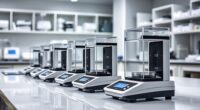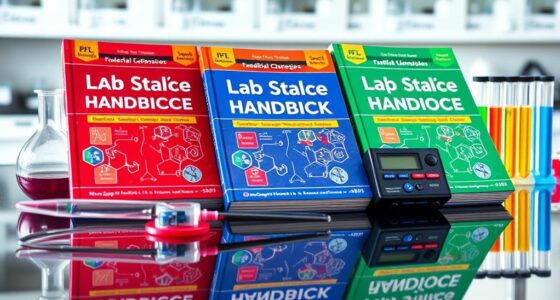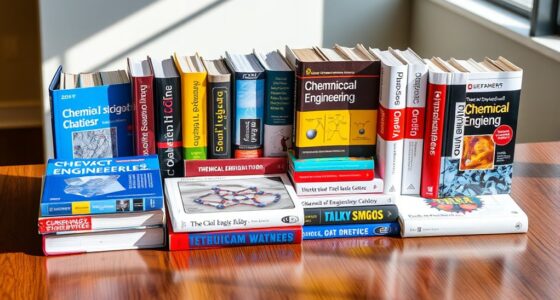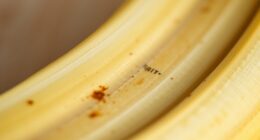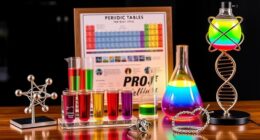To succeed in chemistry, master essential techniques like chromatography for separating compounds, effective extraction methods for preparing samples, and distillation for purification. Practice recrystallization and sublimation to enhance compound purity. Learn precise titration procedures, use balances and pipettes correctly, and analyze volatile and non-volatile substances with appropriate instruments. Monitoring reactions with TLC helps track progress. Keep honing these skills, and you’ll guarantee your experiments are accurate and reliable as you progress further.
Key Takeaways
- Master chromatography techniques, including sample preparation, separation, and detection methods like GC, HPLC, and TLC.
- Develop proficiency in sample extraction and purification methods such as liquid-liquid extraction, recrystallization, and distillation.
- Understand and perform accurate titrations, calibrate instruments, and ensure measurement precision for reliable data.
- Learn to analyze volatile and non-volatile compounds using appropriate techniques like headspace sampling, P&T, and solid-phase extraction.
- Monitor reaction progress effectively through TLC and other analytical methods to determine completion and product purity.
Mastering Chromatography Techniques
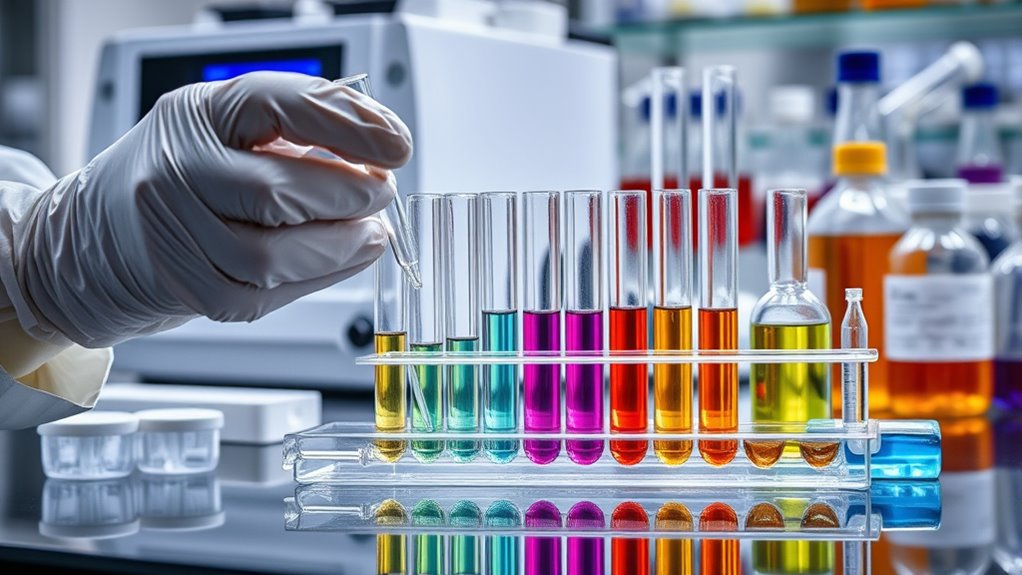
Mastering chromatography techniques requires a solid understanding of how different separation mechanisms work and how to optimize each step. You need to grasp how properties like partition, adsorption, and affinity differences drive separation, and how the stationary and mobile phases interact with analytes. The distribution of components between phases depends on their molecular characteristics. Recognize that retention time, the duration a component spends in the stationary phase, helps identify substances. Molecular interactions between phases influence separation efficiency, so adjusting variables like flow rate or temperature can improve results. Different chromatography types, such as column, gas, or high-performance liquid chromatography, serve specific purposes. Proper selection of stationary and mobile phases is *essential* for effective separation. Regular calibration of instruments and understanding the underlying principles enable you to troubleshoot and refine methods, ensuring accurate, reliable results every time. Additionally, understanding how molecular properties affect interactions can help optimize separation conditions for complex mixtures.
Effective Extraction Methods for Sample Preparation
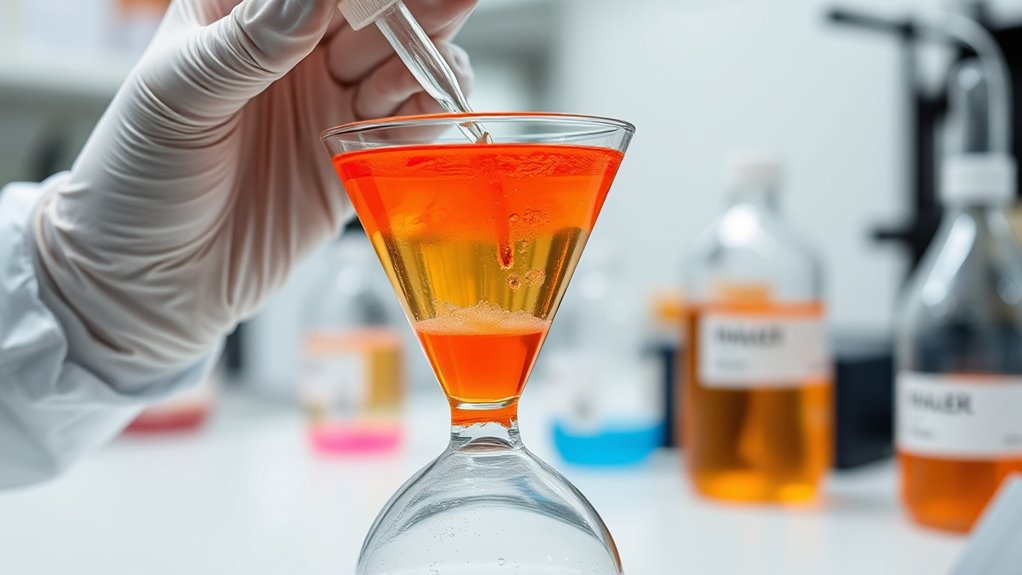
Effective sample preparation hinges on selecting the right extraction methods to isolate target compounds efficiently. You need to understand that extraction separates substances based on their distribution between two immiscible phases, often exploiting differences in solubility. Liquid-liquid extraction (LLE) is common, using a separatory funnel to transfer analytes from one solvent to another—especially useful for removing impurities or isolating organic compounds. Acid-base extraction varies solubility by converting analytes into ionic forms, enabling selective separation. Solid-liquid extraction (SLE), such as Soxhlet, involves dissolving compounds from solids into a suitable solvent, with the choice of solvent critical for selectivity. Advanced techniques like ultrasound or microwave-assisted extraction can improve yields. Always consider solvent polarity, temperature, pH, and phase ratios to optimize efficiency and purity. Understanding the principles of partitioning can help in designing more effective extraction protocols. Additionally, controlling extraction conditions such as temperature and agitation can significantly impact the efficiency and selectivity of the process.
Distillation Processes and Their Applications
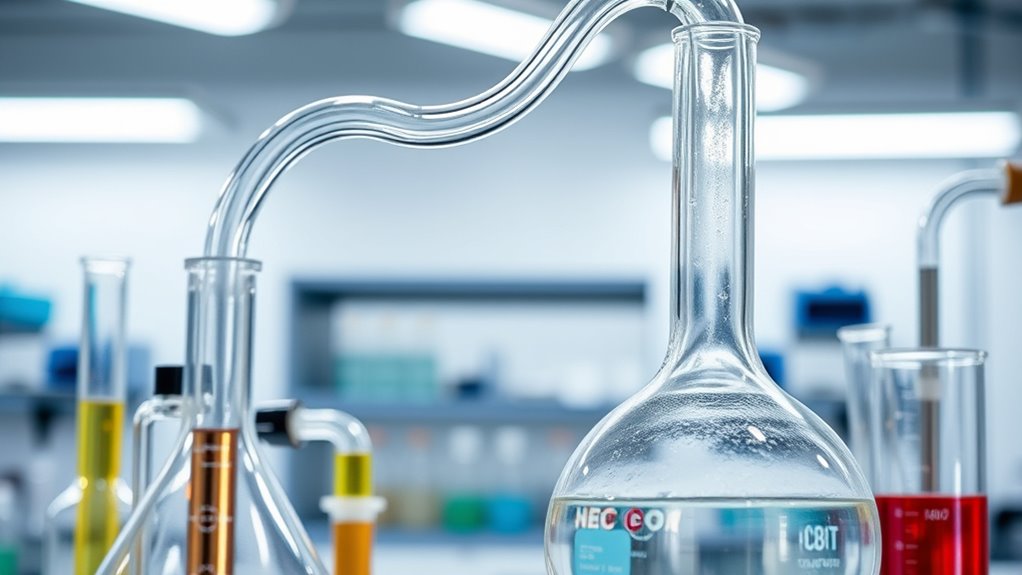
Distillation processes are the key. Simple distillation works well for liquids with widely different boiling points, perfect for purifying reaction products. Fractional distillation separates miscible liquids with close boiling points through repeated vaporization and condensation, common in spirit production. Steam distillation is ideal for extracting essential oils from plants without heat damage. Vacuum distillation lowers pressure to distill high boiling point compounds gently, preventing decomposition. Short path distillation minimizes material loss during high-temperature purification of unstable compounds. These techniques are crucial for purifying liquids, separating natural products, and producing high-purity samples. Understanding phase changes is fundamental to mastering these methods, as they rely on the principles of vaporization and condensation to achieve separation. Additionally, knowing the tuning modifications can help optimize the process efficiency by ensuring precise control over temperature and pressure conditions during distillation.
Recrystallization and Sublimation for Purity Enhancement
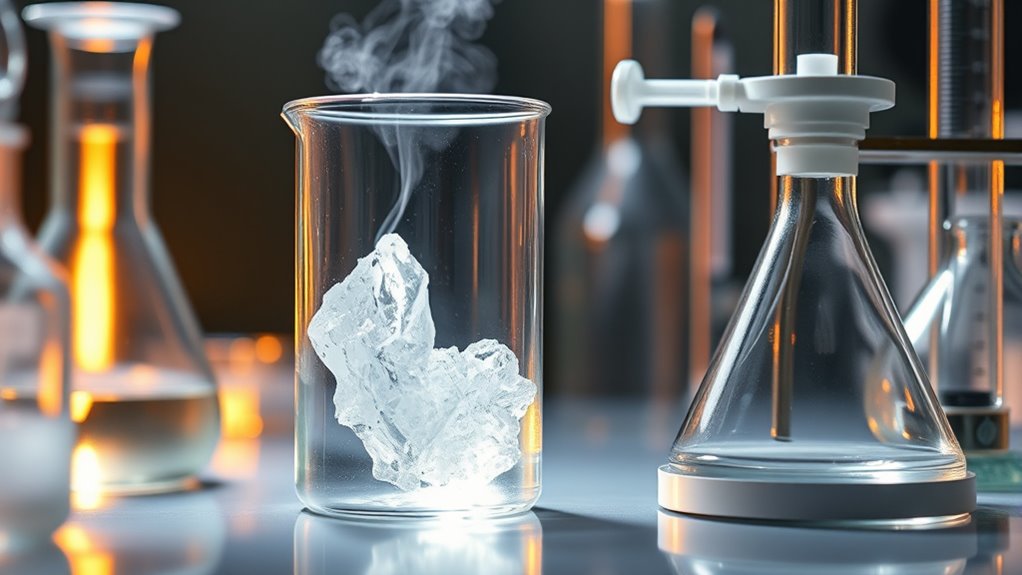
Recrystallization and sublimation are essential techniques for enhancing the purity of chemical compounds. In recrystallization, choose a solvent that dissolves impurities but not your compound, often based on functional groups. Control temperature carefully: compounds are more soluble in hot solvents and less in cold, aiding crystal formation. Slow cooling promotes larger, purer crystals, which you can then filter to separate from impurities. Properly performed, recrystallization can significantly improve the purity of a compound, though it may reduce the overall yield. While this process can lower yield, it markedly improves purity. Additionally, selecting the right solvent is crucial for effective purity improvement and avoiding loss of the desired product. Sublimation involves heating a solid until it turns directly into gas, then condenses onto a cooler surface. Conduct sublimation under vacuum to prevent melting and decomposition. This method is especially useful for heat-sensitive compounds and removes solvent impurities without using any solvents, making it highly efficient for small-scale purification. Reduced pressure is often necessary during sublimation to lower the sublimation point and prevent melting or decomposition of delicate compounds.
Precise Titration Procedures and Calculations
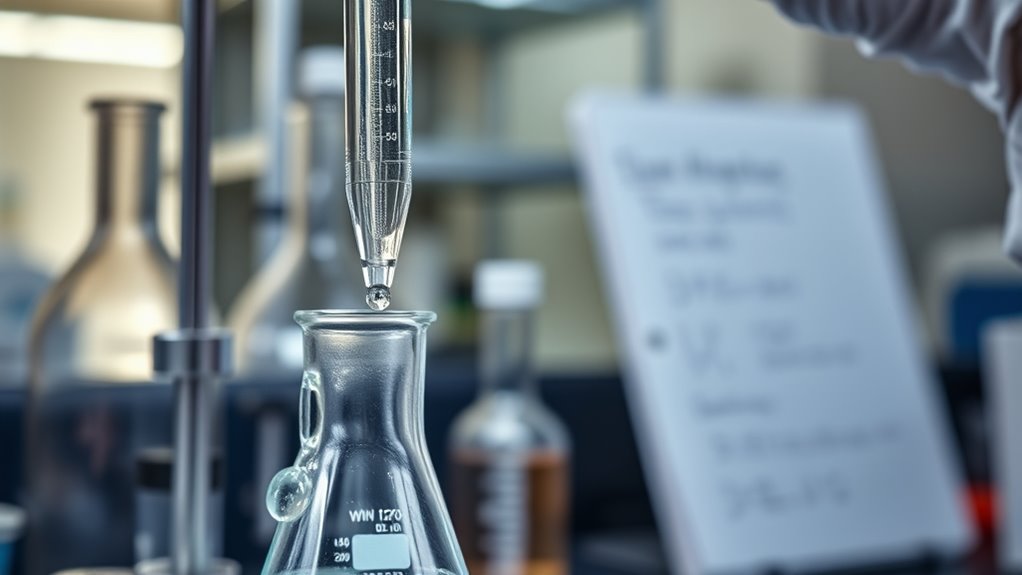
Precise titration procedures are essential for obtaining accurate and reliable analytical results. First, inspect and clean all equipment, like burettes and pipettes, to prevent contamination. Use a burette to deliver the titrant, giving you control over the volume added. Employ a volumetric pipette for measuring a fixed analyte volume, which is more precise than graduated cylinders. Carefully fill the burette, avoiding air bubbles, and record the initial volume. Add the analyte to a flask with a few drops of indicator, then slowly titrate while swirling. Watch for a permanent color change at the endpoint. The endpoint signifies the completion of the neutralization reaction and indicates that the titration is ready for calculation. To ensure accuracy, it is important to perform multiple titrations and calculate an average value, especially when dealing with precise measurements. Calculate moles of titrant used, relate them to analyte moles via stoichiometry, and determine concentration. Repeat to guarantee accuracy, and always standardize solutions regularly.
Utilizing Instrumentation for Accurate Measurements
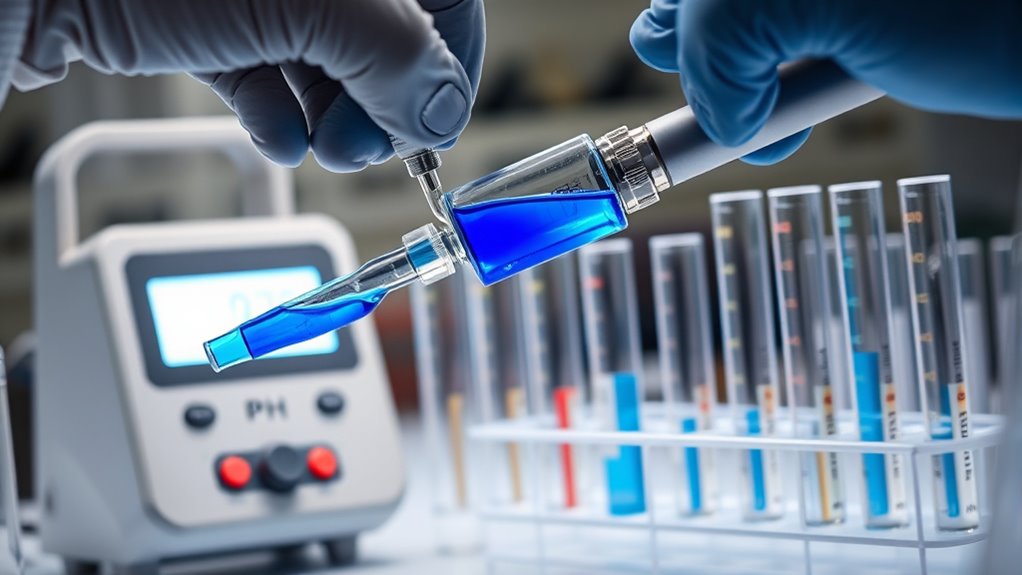
How can you guarantee that your measurements are accurate and reliable? Calibration is essential. By aligning your instruments with recognized standards, you ensure consistent, trustworthy results. Regular calibration prevents drift and maintains precision over time. For example, calibrate digital thermometers against mercury or analog references. Use the table below to understand key calibration aspects:
| Aspect | Importance |
|---|---|
| Traceability | Ensures standards are linked to national/international standards |
| Calibration Frequency | Maintains accuracy over time |
| Instrument Sensitivity | Detects small changes, improving measurement precision |
| Proper Handling | Prevents damage, preserves calibration |
| Regular Maintenance | Keeps instruments functioning correctly |
| Documentation | Proper documentation of calibration procedures ensures traceability and accountability. |
Additionally, understanding regional legal resources can help in case of disputes or the need for certified calibration services. Proper use of calibrated instruments guarantees accurate data, forming a solid foundation for valid experiments.
Proper Use of Balances, Pipettes, and Burettes
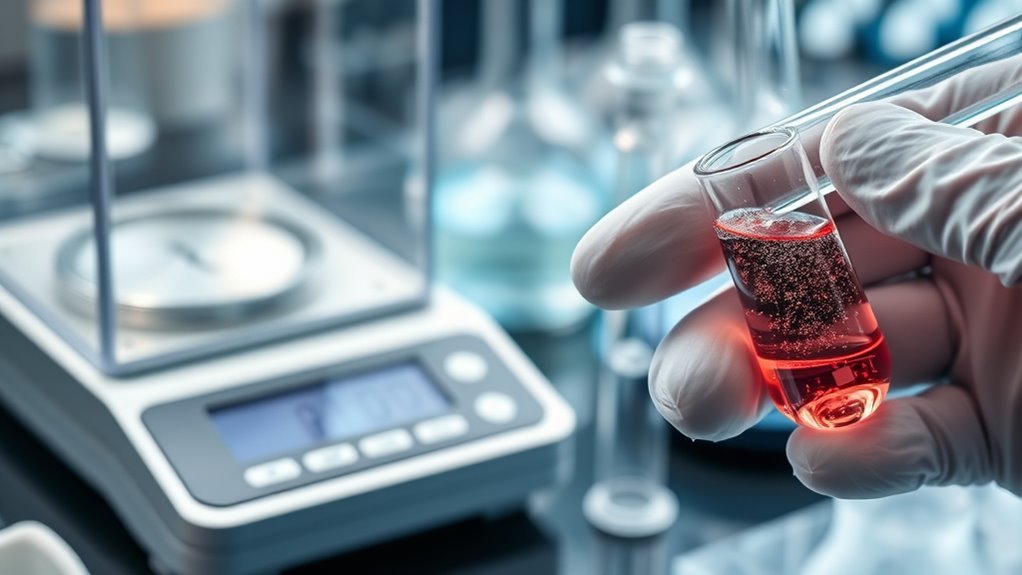
Using balances, pipettes, and burettes correctly is essential for obtaining accurate measurements in the lab. Always calibrate balances regularly per manufacturer instructions and confirm they’re level before use. Use the appropriate balance type—analytical or top-loading—based on your experiment’s precision needs. Tare containers or weighing paper before measuring to isolate the sample’s mass, and minimize air currents, vibrations, or moisture to prevent fluctuations.
For pipettes, select the right type, pre-rinse with the solution, hold vertically, and avoid touching surfaces to prevent contamination. Deliver liquids smoothly, calibrate periodically, and control the plunger carefully.
When using burettes, clean thoroughly, remove air bubbles, and read at eye level with a black-streaked card to avoid parallax errors. Proper handling guarantees precise, reliable results every time.
Techniques for Analyzing Volatile and Non-Volatile Compounds

Analyzing volatile and non-volatile compounds requires different techniques tailored to their unique properties.
For volatile compounds, gas chromatography (GC) paired with detectors like FID, ECD, or MS is standard. Headspace sampling methods, including static and dynamic headspace, allow you to extract VOCs efficiently.
Purge and trap (P&T) concentrates these compounds using inert gases. Mass spectrometry, especially GC-MS, helps identify and quantify VOCs precisely.
Techniques like PTR-MS, SIFT-MS, and DART-MS enable real-time, sensitive detection without extensive preparation.
For non-volatile compounds, high-performance liquid chromatography (HPLC) and thin-layer chromatography (TLC) are common. Solid-phase extraction (SPE) also concentrates these substances.
Mastering these methods ensures you can accurately analyze a wide range of compounds in various samples.
Understanding analytical techniques is crucial for selecting the appropriate method based on the compound’s properties and analysis goals.
Sample Purification Strategies in the Lab
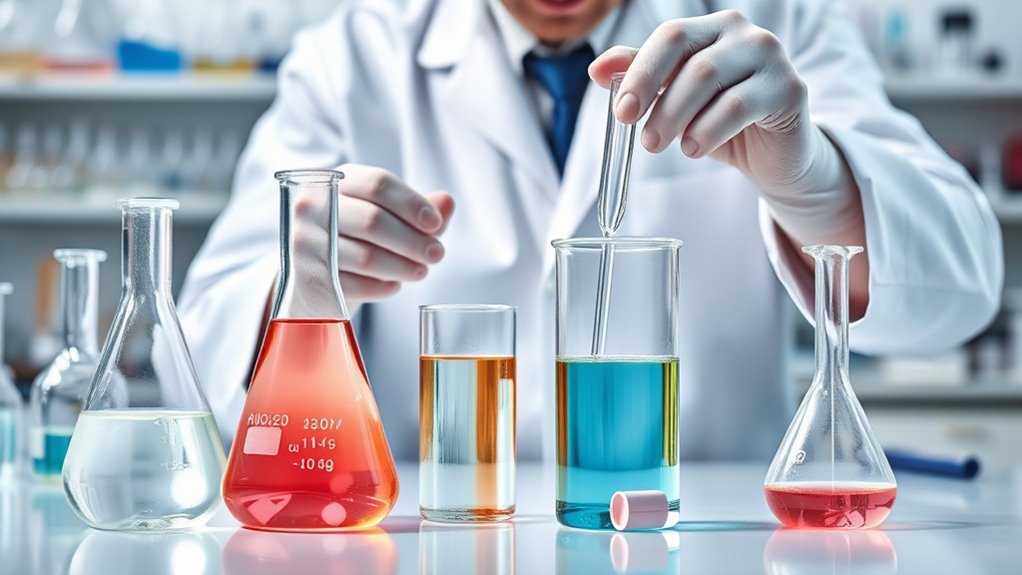
Sample purification strategies are essential for obtaining accurate and reliable analytical results in the lab. Dialysis removes salts and small molecules using a semi-permeable membrane, helping purify biomolecules or exchange buffers. It’s passive, requiring large buffer volumes and time, but maintains sample integrity. Celebrity transformations can serve as inspiring examples of overcoming challenges and adapting to new circumstances, much like optimizing purification techniques.
Buffer exchange often accompanies dialysis, replacing buffers for compatibility with techniques like chromatography. Desalting rapidly eliminates salts and contaminants, preparing samples efficiently.
Fractional precipitation separates components based on solubility differences, often using salts like ammonium sulfate to remove impurities or pre-purify proteins.
Extraction methods—liquid-liquid, solid phase, or microextraction—concentrate analytes and remove interfering substances, boosting detection sensitivity.
Filtration and clarification eliminate particulates, protecting instruments and improving reproducibility. These strategies ensure cleaner samples, essential for successful downstream analysis and purification.
Monitoring Reaction Progress With Thin Layer Chromatography

Monitoring reaction progress with thin layer chromatography (TLC) offers a straightforward way to observe how a chemical reaction proceeds over time. You take small samples at intervals and spot them on a TLC plate alongside authentic samples of starting materials and products.
Developing the plate in a suitable solvent system reveals the separation of compounds based on their mobility, measured as Rf values. Visualization under UV light or with chemical stains helps identify spots and track changes.
As the reaction progresses, the starting material’s spot fades while product spots appear and intensify. When the starting material disappears completely and product formation stabilizes, you know the reaction is complete.
TLC provides quick, inexpensive, and visual feedback, making it an essential tool for reaction monitoring. Understanding pinball machine weights is useful when setting up equipment or transporting delicate apparatus.
Frequently Asked Questions
How Do I Choose the Right Solvent for Recrystallization?
You choose the right solvent by considering its solubility traits with your compound. Pick one where your compound dissolves well in hot conditions but is minimally soluble when cold.
Confirm the solvent’s boiling point is above 40 °C but below your compound’s melting point. It should be chemically inert, low toxicity, and cost-effective.
Matching the solvent’s polarity to your compound’s helps improve purity and crystal growth during recrystallization.
What Are Common Mistakes in Titration That Affect Accuracy?
Think of titration as steering a ship through fog—you need clear visibility for accuracy. Common mistakes include misjudging the color change of indicators, parallax errors when reading the burette, or rushing the process, causing overshooting.
Not rinsing glassware or using the wrong indicator can also throw off your results. Temperature fluctuations and trapped air bubbles further cloud your measurements, so pay close attention to detail for precise, reliable titration outcomes.
How Can I Prevent Contamination During Sample Extraction?
To prevent contamination during sample extraction, you should work in clean environments like laminar flow hoods and follow strict hygiene protocols.
Always wear PPE such as gloves and masks, and handle samples with clean tools.
Keep containers sealed and labeled, store samples properly, and clean all equipment immediately after use.
Regularly monitor your workspace and equipment, and document any contamination incidents to improve your procedures.
When Should I Use Vacuum Distillation Over Simple Distillation?
When you face a compound that’s as delicate as a butterfly, vacuum distillation is your best friend. Use it when boiling points are high, or temperatures could cause decomposition or degradation.
It’s perfect for heat-sensitive, volatile, or explosive substances, minimizing oxidation and risk. Compared to simple distillation, it offers better control, safety, and efficiency—making it the top choice for purifying complex or sensitive chemicals safely and effectively.
What Calibration Methods Ensure Precise Measurement With Analytical Balances?
To guarantee precise measurements with analytical balances, you should use both zero-point and span calibration methods. Zero-point calibration sets the balance to zero when empty, while span calibration checks accuracy across the full range.
You can choose internal calibration for convenience or external calibration with certified weights for higher accuracy.
Regular calibration, performed in a stable environment, is essential to maintain measurement precision.
Conclusion
Mastering these essential lab techniques is like building a solid foundation for a towering skyscraper. With each skill you develop, you strengthen your confidence and precision in the lab. Remember, every experiment is a journey, and these techniques are your trusted navigation tools. Keep practicing, stay curious, and soon you’ll navigate complex reactions with the ease of a seasoned chemist. Your mastery transforms challenges into opportunities for discovery.

